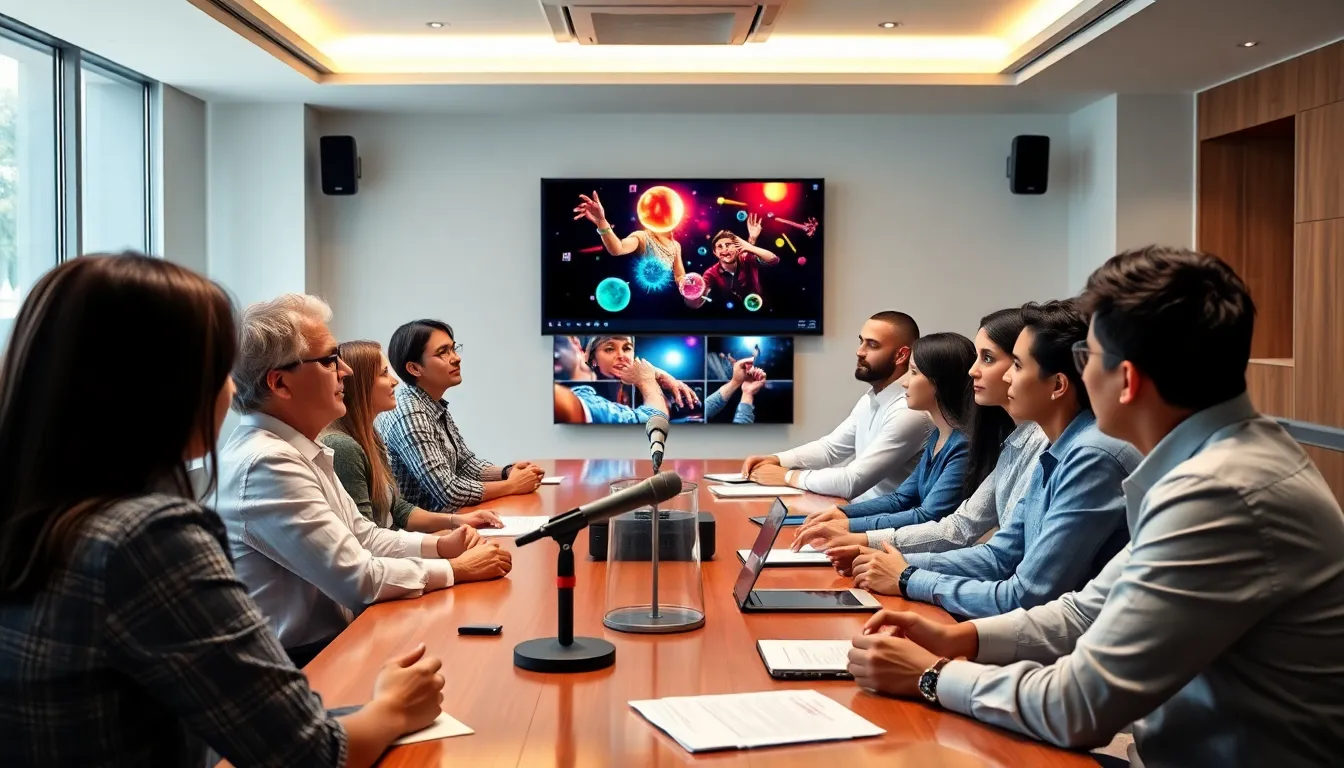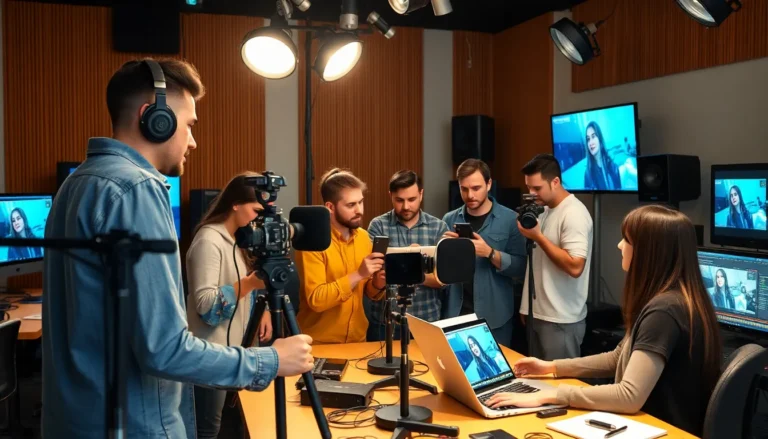In a world where attention spans are shorter than a cat video, audio visual technology swoops in like a superhero, transforming mundane presentations into captivating experiences. It’s not just about flashy screens and booming speakers; it’s about creating connections and sparking emotions. Imagine walking into a room where every flicker of light and every note of sound dances together in perfect harmony.
Table of Contents
ToggleOverview of Audio Visual Technology
Audio visual technology encompasses various tools and techniques that enhance communication and presentation experiences. Integrating audio and video elements fosters better engagement and clarity. Users can create impactful presentations by strategically employing sound effects, video clips, and visual aids.
Tools in this field range from projectors and screens to microphones and sound systems. These components work together to convey messages effectively. Enhanced interactivity often encourages audience participation through real-time feedback and discussions.
Event organizers and educators increasingly rely on audio visual setups to create immersive environments. High-definition visuals combined with high-fidelity audio amplify content retention and understanding. Additionally, advancements in streaming technology allow for remote participation, broadening audience reach.
Incorporating audio visual technology into various settings, such as corporate presentations and educational institutions, improves overall effectiveness. Companies leverage video conferencing and collaborative software to enhance remote interactions. Educational institutions utilize interactive displays and learning management systems to facilitate dynamic learning experiences.
Investing in quality audio visual equipment yields significant returns in audience engagement and satisfaction. Evaluating venues for suitable technology ensures optimal performance. Consideration of acoustics and lighting can significantly enhance the overall impact.
Innovations in this space continuously emerge, shaping the future of communication. Adopting emerging trends keeps presentations fresh and relevant. Understanding the importance of audio visual technology promises to develop stronger connections and foster more memorable interactions.
Key Components of Audio Visual Technology

Audio visual technology comprises essential components that enhance communication and interaction. Understanding these components helps users leverage their full potential.
Audio Equipment
Microphones capture sound and facilitate clear voice transmission. Speakers distribute audio, allowing audiences to hear presentations without difficulty. Sound mixers control audio levels and balance multiple sources, ensuring an optimal listening experience. Amplifiers boost sound output, making it suitable for larger venues. Incorporating sound effects and music can further engage audiences, setting the right tone for presentations. Quality audio equipment remains critical, as poor sound can lead to disengagement and confusion.
Visual Equipment
Projectors display images and videos, transforming any space into a dynamic presentation area. Screens serve as surfaces for projection, ensuring clarity and visibility for all attendees. LED displays offer vibrant visuals and flexibility in size, fit for various environments. Cameras capture live events, facilitating remote participation through streaming. Graphic design software can enhance visuals, ensuring consistency and professionalism. Investing in advanced visual equipment elevates presentations, making them more memorable and effective for both in-person and online audiences.
Applications of Audio Visual Technology
Audio visual technology plays a significant role across multiple industries, enhancing communication and interaction. Below are critical applications in various fields.
Education
Institutions leverage audio visual technology to create engaging learning environments. Interactive displays allow students to participate actively in lessons. Video presentations enhance understanding of complex topics and promote collaboration among peers. High-quality audio equipment ensures that all students, regardless of seating position, hear instructions clearly. Online learning platforms utilize streaming technology to reach remote students, broadening educational access.
Entertainment
The entertainment industry relies on audio visual technology for immersive experiences. Live concerts use advanced sound systems to deliver powerful audio, while vibrant visuals captivate audiences on large screens. Films incorporate high-definition visuals and sound design to enhance storytelling. Virtual reality applications create fully immersive environments, allowing users to engage interactively with content. These technologies continually advance, pushing creative boundaries and redefining audience engagement.
Corporate Settings
In corporate environments, audio visual technology enhances presentations and meetings. Video conferencing tools allow seamless interactions with remote teams, facilitating real-time collaboration. High-resolution projectors display clear visuals, effectively communicating ideas during presentations. Smartboards promote interactive brainstorming sessions, encouraging participation from all team members. Investing in quality equipment yields measurable returns by increasing productivity and enhancing communication across departments.
Benefits of Audio Visual Technology
Audio visual technology enhances engagement in presentations by combining sound and visuals. It transforms conventional communication methods into interactive experiences that captivate audiences. Providing high-definition visuals and clear audio facilitates improved information retention.
Event organizers experience elevated audience participation due to the seamless integration of various audio visual elements. Projectors convey rich imagery, while microphones ensure audible clarity, making it easier for listeners to connect with the material presented.
Collaboration becomes simpler through video conferencing tools. Remote participants join discussions effortlessly, thus expanding the reach of presentations to a broader audience. Educators utilize this technology to create interactive learning environments that foster student involvement and comprehension.
In the corporate realm, teams incorporate smartboards and interactive displays to stimulate brainstorming sessions and enhance productivity. Visual aids support various learning styles, making complex information more digestible.
Investments in quality audio visual equipment yield considerable returns in engagement and satisfaction. Analyzing venue capabilities ensures that events align with technological demands. Innovations continuously shape audio visual technology, elevating communication standards across industries.
Utilizing these tools ensures that educational presentations remain relevant and impactful. Live events in entertainment also benefit from immersive audio visuals that create memorable experiences. Organizations that prioritize audio visual technology notice significant improvements in stakeholder communication.
Challenges in Audio Visual Technology
Audio visual technology faces various challenges impacting its effectiveness and integration. High costs can deter organizations from investing in advanced equipment, limiting access to innovative tools. Technical difficulties may arise during presentations, disrupting flow and diminishing audience engagement. Insufficient training for users often leads to underutilization of available features, creating missed opportunities for enhancing communication.
Compatibility issues between devices can further complicate setups. Not all audio visual systems work seamlessly together, leading to potential failures during critical moments. Additionally, rapidly evolving technology can result in equipment becoming outdated quickly, challenging organizations to keep pace with advancements.
Security concerns surrounding data breaches and unauthorized access to devices also present challenges. Protecting sensitive information is vital, particularly in corporate settings where confidential discussions occur. Expanding use of cloud-based systems raises further security issues, necessitating vigilance regarding data protection protocols.
Limited physical space in venues can restrict how equipment is arranged, impacting visibility and sound quality. Event planners must consider acoustics and sightlines to optimize the audience experience. Furthermore, consistent maintenance of audio visual equipment is essential for reliable performance, yet often neglected, leading to deterioration over time.
While audio visual technology enhances communication and engagement, overcoming these challenges is crucial for maximizing benefits. Organizations that prioritize quality equipment, proper training, and ongoing support achieve higher engagement and satisfaction rates among their audiences. By proactively addressing these obstacles, they foster better connections and ensure the longevity of their audio visual setups.
Audio visual technology is a game changer for effective communication across various sectors. Its ability to create immersive experiences enhances audience engagement and fosters meaningful connections. By investing in quality equipment and embracing innovative techniques, organizations can elevate their presentations and learning environments.
Addressing challenges like technical difficulties and training gaps is essential for maximizing the benefits of this technology. As advancements continue to emerge, staying updated will ensure presentations remain impactful and relevant. Prioritizing audio visual solutions not only enriches interactions but also drives satisfaction and retention, making it a crucial element in today’s communication landscape.







